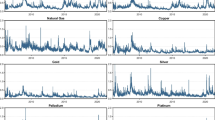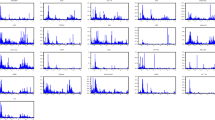Abstract
In this paper, we examine extreme spillovers among the realized volatility of various energy, metals, and agricultural commodities over the period from September 23, 2008, to June 1, 2020. Using high-frequency (5-min) price data on commodity futures, we compute daily realized volatility and then apply quantile-based connectedness measures. The results show that the connectedness measures estimated at the lower and upper quantiles are much higher than those estimated at the median, implying that realized volatility shocks circulate more intensely during extreme events relative to normal periods, which endangers the stability of the system of volatility connectedness under extreme events such as the COVID19 outbreak. There is evidence of a strong asymmetry between the behaviour of volatility spillovers in lower and upper quantiles, given that the connectedness measures estimated at the upper quantile are the highest. The main results are robust to rolling window size and other alternative choices. Our analyses matter to investors and policy makers who are concerned with the stability of commodity markets.















Similar content being viewed by others
Notes
In this regard, Degiannakis et al. (2020) has recently used high frequency data on major agricultural commodities (corn, rough rice, soybeans, sugar, and wheat) from the CME/ICE within the heterogeneous autoregressive (HAR) model to forecast the realized volatility of those agricultural commodities.
A recent paper dealing with the quantile spillovers among Asia–Pacific currencies has applied a comparable approach (Bouri et al. 2020).
The authors show that it is very difficult to beat the forecasting ability of the 5-min realized variance measure.
We thank an anonymous reviewer for making this important suggestion.
Results of the GSDAF on the first differences of volatility series are available from the authors upon request.
The TCI varies between 0 and 100.
References
Abid, I., Dhaoui, A., Goutte, S., & Guesmi, K. (2020). Hedging and diversification across commodity assets. Applied Economics, 52(23), 2472–2492.
Acharya, V. L., Pedersen, L. H., Philippon, T., & Richardson, M. P. (2017). Measuring systemic risk. Review of Financial Studies, 30(1), 2–47.
Adekoya, O. B., & Oliyide, J. A. (2020). How COVID-19 drives connectedness among commodity and financial markets: Evidence from TVP-VAR and causality-in-quantiles techniques. Resources Policy, 101898.
Adrian, T., & Brunnermeier, M. K. (2016). CoVaR. American Economic Review, 106(7), 1705–1741.
Ali, S., Bouri, E., Czudaj, R. L., & Shahzad, S. J. H. (2020). Revisiting the valuable roles of commodities for international stock markets. Resources Policy, 66, 101603.
Ando, T., Greenwood-Nimmo, M., & Shin, Y. (2018). Quantile connectedness: Modelling tail behaviour in the topology of financial networks. Available at SSRN 3164772.
Andriosopoulos, K., Galariotis, E., & Spyrou, S. (2017). Contagion, volatility persistence and volatility spill-overs: The case of energy markets during the European financial crisis. Energy Economics, 66, 217–227.
Baker, S. R., Bloom, N., Davis, S. J., Kost, K. J., Sammon, M. C., & Viratyosin, T. (2020). The unprecedented stock market impact of COVID-19: National Bureau of Economic Research.
Barichello, R. (2020). The COVID-19 pandemic: Anticipating its effects on Canada’s agricultural trade. Canadian Journal of Agricultural Economics/Revue canadienne d’agroeconomie, 68, 219–224.
Baur, D. G., & Dimpfl, T. (2018). The asymmetric return-volatility relationship of commodity prices. Energy Economics, 76, 378–387.
Ben Ameur, H., Ftiti, Z., Jawadi, F., & Louhichi, W. (2020). Measuring extreme risk dependence between the oil and gas markets. Annals of Operations Research. https://doi.org/10.1007/s10479-020-03796-1
Bouri, E., Lucey, B., Saeed, T., & Vo, X. V. (2020). Extreme spillovers across Asian-Pacific currencies: A quantile-based analysis. International Review of Financial Analysis, 72, ss.
Bouri, E., Lucey, B., Saeed, T., & Vo, X. V. (2021). The realized volatility of commodity futures: Interconnectedness and determinants. International Review of Economics and Finance, 73, 139–151.
Cabrera, B. L., & Schulz, F. (2016). Volatility linkages between energy and agricultural commodity prices. Energy Economics, 54, 190–203.
Cheng, I.-H., & Xiong, W. (2014). Financialization of commodity markets. Annual Review of Financial Economics, 6(1), 419–441.
Christoffersen, P., Lunde, A., & Olesen, K. V. (2019). Factor structure in commodity futures return and volatility. Journal of Financial and Quantitative Analysis, 54(3), 1083–1115.
Corbet, S., Larkin, C., & Lucey, B. (2020). The contagion effects of the covid-19 pandemic: Evidence from gold and cryptocurrencies. Finance Research Letters, 35, 101554.
Degiannakis, S. (2008). ARFIMAX and ARFIMAX-TARCH realized volatility modeling. Journal of Applied Statistics, 35(10), 1169–1180.
Degiannakis, S., Filis, G., Klein, T., & Walther, T. (2020). Forecasting realized volatility of agricultural commodities. International Journal of Forecasting. https://doi.org/10.1016/j.ijforecast.2019.08.011
Diebold, F. X., & Yılmaz, K. (2014). On the network topology of variance decompositions: Measuring the connectedness of financial firms. Journal of Econometrics, 182(1), 119–134.
Dutta, A., Bouri, E., & Roubaud, D. (2019). Nonlinear relationships amongst the implied volatilities of crude oil and precious metals. Resources Policy, 61, 473–478.
Erb, C. B., & Harvey, C. R. (2006). The strategic and tactical value of commodity futures. Financial Analysts Journal, 62(2), 69–97.
Etienne, X. L., Irwin, S. H., & Garcia, P. (2014). Bubbles in food commodity markets: Four decades of evidence. Journal of International Money and Finance, 42, 129–155.
Figuerola-Ferretti, I., McCrorie, J. R., & Paraskevopoulos, I. (2020). Mild explosivity in recent crude oil prices. Energy Economics, 87, 104387.
Henriksen, T. E. S., Pichler, A., Westgaard, S., & Frydenberg, S. (2019). Can commodities dominate stock and bond portfolios? Annals of Operations Research, 282(1), 155–177.
Hu, M., Zhang, D., Ji, Q., & Wei, L. (2020). Macro factors and the realized volatility of commodities: A dynamic network analysis. Resources Policy, 68, 101813.
Iqbal, N., Fareed, Z., Guangcai, W., & Shahzad, F. (2020). Asymmetric nexus between COVID-19 outbreak in the world and cryptocurrency market. International Review of Financial Analysis, 73, 101613.
Ji, Q., Bouri, E., Roubaud, D., & Shahzad, S. J. H. (2018). Risk spillover between energy and agricultural commodity markets: A dependence-switching CoVaR-copula model. Energy Economics, 75, 14–27.
Junttila, J., Pesonen, J., & Raatikainen, J. (2018). Commodity market based hedging against stock market risk in times of financial crisis: The case of crude oil and gold. Journal of International Financial Markets, Institutions and Money, 56, 255–280.
Kang, S. H., McIver, R., & Yoon, S.-M. (2017). Dynamic spillover effects among crude oil, precious metal, and agricultural commodity futures markets. Energy Economics, 62, 19–32.
Koenker, R. (2005). Quantile Regression (Econometric Society Monographs). Cambridge University Press. https://doi.org/10.1017/CBO9780511754098
Kruse, R., & Wegener, C. (2020). Time-varying persistence in real oil prices and its determinant. Energy Economics, 85, 104328.
Liu, L. Y., Patton, A. J., & Sheppard, K. (2015). Does anything beat 5-minute RV? A comparison of realized measures across multiple asset classes. Journal of Econometrics, 187(1), 293–311.
Lu, X. F., Lai, K. K., & Liang, L. (2014). Portfolio value-at-risk estimation in energy futures markets with time-varying copula-GARCH model. Annals of Operations Research, 219(1), 333–357.
Luo, J., Klein, T., Ji, Q., & Hou, C. (2019). Forecasting realized volatility of agricultural commodity futures with infinite Hidden Markov HAR models. International Journal of Forecasting. https://doi.org/10.1016/j.ijforecast.2019.08.007
Manahov, V. (2018). The rise of the machines in commodities markets: New evidence obtained using Strongly Typed Genetic Programming. Annals of Operations Research, 260(1), 321–352.
Meng, J., Nie, H., Mo, B., & Jiang, Y. (2020). Risk spillover effects from global crude oil market to China’s commodity sectors. Energy, 202, 117208.
Mensi, W., Hammoudeh, S., Nguyen, D. K., & Yoon, S.-M. (2014). Dynamic spillovers among major energy and cereal commodity prices. Energy Economics, 43, 225–243.
Mensi, W., Tiwari, A., Bouri, E., Roubaud, D., & Al-Yahyaee, K. H. (2017). The dependence structure across oil, wheat, and corn: A wavelet-based copula approach using implied volatility indexes. Energy Economics, 66, 122–139.
Mo, D., Gupta, R., Li, B., & Singh, T. (2018). The macroeconomic determinants of commodity futures volatility: Evidence from Chinese and Indian markets. Economic Modelling, 70, 543–560.
Nazlioglu, S., Erdem, C., & Soytas, U. (2013). Volatility spillover between oil and agricultural commodity markets. Energy Economics, 36, 658–665.
Nguyen, D. K., & Walther, T. (2020). Modeling and forecasting commodity market volatility with long-term economic and financial variables. Journal of Forecasting, 39(2), 126–142.
Omura, A., & Todorova, N. (2019). The quantile dependence of commodity futures markets on news sentiment. Journal of Futures Markets, 39(7), 818–837.
Phillips, P. C., Shi, S., & Yu, J. (2015). Testing for multiple bubbles: Limit theory of real-time detectors. International Economic Review, 56(4), 1079–1134.
Salisu, A. A., Akanni, L., & Raheem, I. (2020). The COVID-19 global fear index and the predictability of commodity price returns. Journal of Behavioral and Experimental Finance, 27, 100383.
Sensoy, A. (2013). Dynamic relationship between precious metals. Resources Policy, 38(4), 504–511.
Shi, S., Phillips, P. C., & Hurn, S. (2018). Change detection and the causal impact of the yield curve. Journal of Time Series Analysis, 39(6), 966–987.
Silvennoinen, A., & Thorp, S. (2013). Financialization, crisis and commodity correlation dynamics. Journal of International Financial Markets, Institutions and Money, 24, 42–65.
Topaloglou, N., Vladimirou, H., & Zenios, S. A. (2020). Integrated dynamic models for hedging international portfolio risks. European Journal of Operational Research, 285(1), 48–65.
Uddin, G. S., Rahman, M. L., Shahzad, S. J. H., & Rehman, M. U. (2018). Supply and demand driven oil price changes and their non-linear impact on precious metal returns: A Markov regime switching approach. Energy Economics, 73, 108–121.
Vivian, A., & Wohar, M. E. (2012). Commodity volatility breaks. Journal of International Financial Markets, Institutions and Money, 22(2), 395–422.
Watugala, S. W. (2019). Economic uncertainty, trading activity, and commodity futures volatility. Journal of Futures Markets, 39(8), 921–945.
Yang, J., Balyeat, R. B., & Leatham, D. J. (2005). Futures trading activity and commodity cash price volatility. Journal of Business Finance and Accounting, 32(1–2), 297–323.
Acknowledgement
Najaf Iqbal gratefully acknowledges the support from Academic Financial Aid Project for Top Talents in Universities of Anhui via grant number gxbjZD14.
Author information
Authors and Affiliations
Corresponding author
Additional information
Publisher's Note
Springer Nature remains neutral with regard to jurisdictional claims in published maps and institutional affiliations.
Rights and permissions
About this article
Cite this article
Iqbal, N., Bouri, E., Grebinevych, O. et al. Modelling extreme risk spillovers in the commodity markets around crisis periods including COVID19. Ann Oper Res 330, 305–334 (2023). https://doi.org/10.1007/s10479-022-04522-9
Accepted:
Published:
Issue Date:
DOI: https://doi.org/10.1007/s10479-022-04522-9




